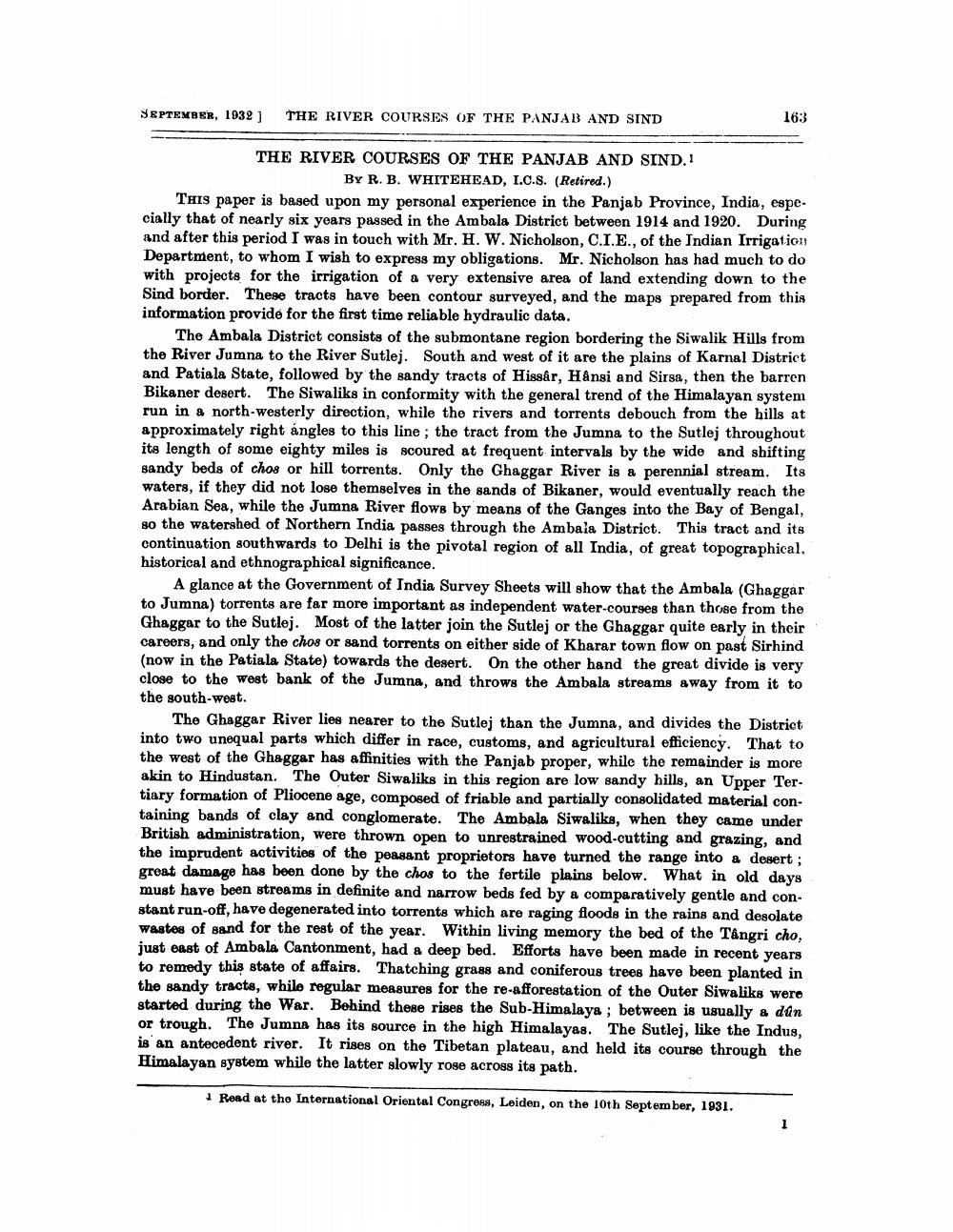________________
SEPTEMBER, 1932]
THE RIVER COURSES OF THE PANJAB AND SIND
163
THE RIVER COURSES OF THE PANJAB AND SIND.
BY R. B. WHITEHEAD, L.C.S. (Retired.) This paper is based upon my personal experience in the Panjab Province, India, espe. cially that of nearly six years passed in the Ambala District between 1914 and 1920. During and after this period I was in touch with Mr. H. W. Nicholson, C.I.E., of the Indian Irrigation Department, to whom I wish to express my obligations. Mr. Nicholson has had much to do with projects for the irrigation of a very extensive area of land extending down to the Sind border. These tracts have been contour surveyed, and the maps prepared from this information provide for the first time reliable hydraulic data.
The Ambala District consists of the submontane region bordering the Siwalik Hills from the River Jumna to the River Sutlej. South and west of it are the plains of Karnal District and Patiala State, followed by the sandy tracts of Hissar, Hânsi and Sirsa, then the barren Bikaner desert. The Siwaliks in conformity with the general trend of the Himalayan system run in a north-westerly direction, while the rivers and torrents debouch from the hills at approximately right angles to this line; the tract from the Jumna to the Sutlej throughout its length of some eighty miles is scoured at frequent intervals by the wide and shifting sandy beds of chos or hill torrents. Only the Ghaggar River is a perennial stream. Its waters, if they did not lose themselves in the sands of Bikaner, would eventually reach the Arabian Sea, while the Jumna River flows by means of the Ganges into the Bay of Bengal, so the watershed of Northern India passes through the Ambala District. This tract and its continuation southwards to Delhi is the pivotal region of all India, of great topographical, historical and ethnographical significance.
A glance at the Government of India Survey Sheets will show that the Ambala (Ghaggar to Jumna) torrents are far more important as independent water-courses than those from the Ghaggar to the Sutlej. Most of the latter join the Sutlej or the Chaggar quite early in their careers, and only the chos or sand torrents on either side of Kharar town flow on past Sirhind (now in the Patiala State) towards the desert. On the other hand the great divide is very close to the west bank of the Jumna, and throws the Ambala streams away from it to the south-west.
The Ghaggar River lies nearer to the Sutlej than the Jumna, and divides the District into two unequal parts which differ in race, customs, and agricultural efficiency. That to the west of the Ghaggar has affinities with the Panjab proper, while the remainder is more akin to Hindustan. The Outer Siwaliks in this region are low sandy hills, an Upper Tertiary formation of Pliocene age, composed of friable and partially consolidated material containing bands of clay and conglomerate. The Ambala Siwaliks, when they came under British administration, were thrown open to unrestrained wood-cutting and grazing, and the imprudent activities of the peasant proprietors have turned the range into a desert; great damage has been done by the chos to the fertile plains below. What in old days must have been streams in definite and narrow beds fed by a comparatively gentle and constant run-off, have degenerated into torrents which are raging floods in the rains and desolate wastes of sand for the rest of the year. Within living memory the bed of the Tångri cho, just east of Ambala Cantonment, had a deep bed. Efforts have been made in recent years to remedy this state of affairs. Thatching grass and coniferous trees have been planted in the sandy tracts, while regular measures for the re-afforestation of the Outer Siwaliks were started during the War. Behind these rises the Sub-Himalaya ; between is usually & din or trough. The Jumna has its source in the high Himalayas. The Sutlej, like the Indus, is an antecedent river. It rises on the Tibetan plateau, and held its course through the Himalayan system while the latter slowly rose across its path.
Read at the International Oriental Congress, Leiden, on the 10th September, 1931.




